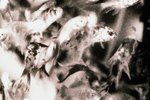
Like all vertebrates, a goldfish has got to eat. Your goldfish uses a number of senses, including ones humans don't have, to find food. They use their specialized vision, their lateral line organs and their sense of smell to locate tasty morsels.
Vision

A goldfish is a primarily visual hunter, meaning it hunts with its sense of sight. However, goldfish have specialized vision. Believe it or not, your goldfish can see more colors than you can. Human eyes can see only three primary colors: red, blue and yellow. All other colors are mixtures of these. A goldfish can see four, making it a tetrachromate. Part of the goldfish's visual spectrum includes UV light, which penetrates water better than light visible to humans. With these adaptations, a goldfish can easily spot movement and zero in on prey.
Lateral Line

Most fish—including the humble goldfish—have a special organ called the lateral line on each side of their bodies. This gives fish a sense humans don't have. The lateral line is a series of pits. These pits sense subtle changes in water movement and pressure, creating a sense that's almost like hearing, touch, balance and sonar rolled into one. Some fish, like sharks and electric eels, take this further, and can sense electrical fields with this organ. While your goldfish doesn't take this little superpower that far, a goldfish can use this sense to detect disturbances in the water, like prey foods or fish flakes splashing against the water's surface.
Smell

Your goldfish also has a sense of smell to tip it off when food's nearby. However, goldfish have very different noses from humans. Unlike a mammal's schnoz, the nose of a goldfish does not connect to the mouth or the breathing system. Instead, the nose consists of two blind pits with smell-sensing receptors inside. Water flows in and out of these pits, carrying information that the receptors relay to the fish's brain.
Goldfish Food

In the wild, a goldfish is an enthusiastic omnivore, eating both small animal foods and plants. In the home aquarium, you need to replicate this diet. Flake and pellet foods make a good staple, but your goldfish will benefit from treats. These improve digestion, and satisfy a goldfish's hunting instincts. You can feed a goldfish vegetable matter, like aquarium plants. Duckweed and anacharis make great green treats. You can also feed animal foods like brine shrimp and Daphnia water fleas. You can pick these foods up at most pet shops.
References
- Journal of Comparative Physiology: Tetrachromatic Vision in Goldfish: Evidence From Color Mixture Experiments
- FishChannel.com: Tropical Fish Word of the Day: Lateral Line
- Journal of Comparative Physiology: The Role of Background Movement in Goldfish Vision
- Animal Planet: Goldfish
- FishChannel.com: Feeding Koi and Goldfish
Photo Credits
-
Viewstock/Photodisc/Getty Images




